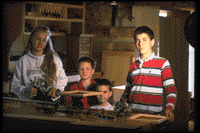| While satisfying to use, these tools are also surprisingly efficient, and if you are
woodworking for pleasure you will find these tools can add an entirely new dimension to
your hobby. We hope that by presenting some of what we've learned over the last few years
you will be able to enjoy using these and similar planes as much as we have. Combination planes were meant to perform more than one distinct
operation, and there were wooden combination
planes long before Stanley introduced their line of metallic combination planes in the
last quarter of the 19th century. There were also many other manufacturers of metal
combination planes associated with other patents. These were often produced in relatively
small quantities and are collector's items today, priced well outside what most people
would pay for a "user" plane. The Stanley planes were by far the most successful
due to their ease of operation and elegance of their design. Although Stanley discontinued
most of their planes by 1962, there are still combination planes based on their designs
being made by other companies today.
When we started our shop, we had to purchase all the planes that we were going to use;
planes in the museum's collection are not allowed to be sharpened or used. We found that
the characteristics that allows relatively expensive metal combination planes to compete
against cheaper wooden planes over one hundred years ago to be even more important today.
It may be a regional problem, but we have found that most of the wooden moulding planes we
look at have dried out over the years and no longer fit their irons. Preparing these
planes for use usually involves re-grinding the new profile of the plane's sole into the
iron. Besides taking a great deal of time, it really goes against the grain in a museum to
completely rework an antique tool, whether its part of the collection or not. There's also
the question of availability and cost. Some of the Stanley combination planes could
replace dozens of wooden moulding planes, and that is a tremendous advantage when setting
up a new shop.
Many old-timers didn't like the new planes, preferring the look and feel of wooden
planes to the new-fangled designs. To help overcome this bias, the Stanley company went
out of its way to make the early metallic combination planes as ornate and decorative as
possible. To the 20th century eye, these planes are beautiful examples of Victorian
metalwork, with floral motifs cast into plane bodies and fences. Rosewood handles and
brass fittings add to the planes' elegance, making them as much showpieces as practical
tools.
There is one drawback with resurrecting and using these old tools. In the second half
of the last century screw threads had just begun to standardize. However many designs
called for screws of a thread size that a century later have become totally obsolete and
are impossible to find. Stanley designs were no exception, so finding spare thumbscrews
and other pieces for their older tools can be frustrating and expensive. Worse yet,
previous owners may have forced a modern machine screw into service and stripped the
threads in the plane.
No workshop needs the variety of combination planes presented here. We find that each
type has its own strengths and weaknesses, and we generally use each plane for a
particular application at which it excels.

Copyright 1999 01 Inc., NYC |


